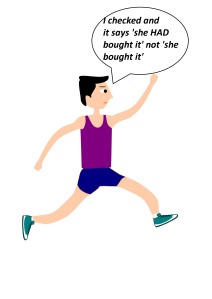Yesterday I was talking to a colleague about how challenging students are what helps us develop as teachers – you have to think on your feet and constantly think of ideas to keep them interested, awake and out of trouble. It made me think of one of my favorite activities in class – Running Dictation and how I had to adapt it to make it cheat-proof. More on that later, but now let’s see what Running Dictation is and how it can help avoid situations like this (true story and I didn’t know whether to laugh or cry at the time)

What is Running Dictation?
As you can probably guess from the name, it involves running and dictating.
- The teacher selects a text for dictation – depending on the level and the language you want your students to notice/practice. The text could be something you create yourself or a text from your textbook.
- Students are organized into groups (or pairs if you have a smaller class). One person in each group will be a writer (or secretary), other members of the group will become runners. Make sure students rotate their roles and take turns being writers and runners.
- Set the rules. Some important rules are that there can be only one runner at a time in a group and they cannot use any recording devices – i.e. no mobile phones or pens and papers or shout their sentences across the room.
- The teacher either keeps the copy of the text on them, or makes several copies and puts them up in class or outside of the class. The first option is the easiest in terms of control. The second option still lets you keep an eye on everything, but lets the students spread around. Putting the texts outside the class provides students with a bigger outlet for their energy – they will need to run further, but it’ll be harder to check that no cheating is going on (e.g. students aren’t taking sneaky photos of the text) and you need to make sure you aren’t disrupting other classes.
- The runners look at the text and try to memorize as much as they can before running back to their partner(s) and dictating their portion of the text. The runners can go back as many times as they need in order to complete the text, as long as they follow the rules.
- When a group says they are done, the teacher checks the text, and either accepts it or asks the group to work on it some more. Alternatively, the students get the original text and compare it with their version.
- Make sure there is a follow-up to the dictation – the follow-up can include focus on grammar, answering questions about the text, re-arranging the sentences or parts of the text (see below for ideas).
Why do Running Dictation?
The greatest thing about running dictation is its potential for shaking up your lesson – by getting your students moving and competing with each other, you get them excited about the topic at hand. Obviously, you wouldn’t want to do this every lesson or the activity will lose its appeal, but using it now and again will help you energize your class.
In addition, running dictation is a fun way to introduce/practice procedural and functional language – e.g. How do you spell that? Sorry, did you say we WANT or we WANTED? Also: capital letter, comma, new sentence, new paragraph etc.
Finally, and most importantly, this activity gets students to use a variety of skills and processes – speaking, listening reading, writing, negotiating of meaning, and engaging short-term memory. This also means the activity has the potential to engage learners with various leaning preferences. Now, how cool is that?
Grammar focus
You can use running dictation to help students notice certain language points. The text you s elect/create can contain a high occurrence of certain grammar items, e.g. articles or sentences with third person singular in Present Simple.
elect/create can contain a high occurrence of certain grammar items, e.g. articles or sentences with third person singular in Present Simple.
Let’s say you want to focus on the use of present continuous to describe annoying habits. The text would contain sentences like ‘My partner is always copying my homework’ and after the students have the complete text, you could ask them questions like ‘Are the sentences about what is happening now or what happens regularly? How do we know? How does the author feel about these things’?.
